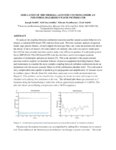TO
| Title | Date | Subject | Description | ||
|---|---|---|---|---|---|
| 26 |
 |
Three canister regenerative thermal oxidizer with secondary & tertiary heat recovery | This system layout was initially developed for a Metal Finishing operation to have a Regenerative Thermal Oxidizer, as a pollution control device, and at the same time recycles hot air back into the process. There is a Secondary Heat Exchanger, which recovers un-used heat from the Regenerative Therm... | ||
| 27 |
 |
Simulation of the thermal-acoustic coupling inside an industrial hazardous waste incinerator | To analyze the coupling between combustion reactions and the natural acoustic behavior of a reactor, a transient LES based CFD code has been used. Previous transient analysis of ignition inside large process heaters, of multi-tipped elevated gas flares and waste incinerators has shown the ability of... | ||
| 28 |
 |
Modeling sulfur-Nitrogen chemistry indside a claus reaction furnace | This paper describes a CFD analysis of a Sulfur Recovery Unit (SRU) considering transient turbulent reacting flow inside the SRU. Often, the SRU feedstock includes hydrocarbons together with nitrogen and sulfur species, which react with oxygen in the air to form various emissions including SO2, NH3 ... | ||
| 29 |
 |
New developments in flaring liquid natural gas without vaporization of the waste stream | 2020 | This paper will explore best practices and lessons learned during the development, testing, and implementation of a mechanically atomized multi-jet liquid flare for liquified natural gas (LNG). Liquefaction facilities convert natural gas into LNG by cooling it to a liquid state at -259⁰F (- 162⁰... | |
| 30 |
 |
Flare combustion index in lieu of combustion zone net heating value | 2020 | Flares are commonly used at industrial facilities (e.g., oil and gas extraction and production sites, gas processing plants, oil refineries, and petrochemical manufacturing plants) to safely dispose of process waste gases. Waste gases may be produced due to process upset or because they are unrecove... | |
| 31 |
 |
Hardening of arches for commercial simulation of industrial flares: a program update | Reaction Engineering International (REI) is working with the University of Utah to leverage the Uintah Computational Framework (UCF) for commercial simulation of industrial flares, with funding from the Department of Energy (DOE). The Arches component of the UCF provides a reacting large eddy simula... | ||
| 32 |
 |
Design Considerations for Carbon-Free Combustion | Decarbonization; Hydrogen Combustion; Carbon Dioxide; Carbon-Free Combustion; CO2 Emissions; Greenhouse Gas Emissions | Combustion of a hydrocarbon produces water and carbon dioxide. As consensus continues to build around the contributions of carbon in global client change, jurisdictions, both internationally as well as domestically, are working towards limiting formation of carbon dioxide. One way to work toward eff... | |
| 33 |
 |
ClearSign eye™: pilot sensor | Clearsign Technologies Corp. has developed and tested a novel, capacitive based flame sensor for use on existing burners in a variety of industrial combustion applications including process burners, boiler burners and flares. ClearSign has developed two probe designs. The first probe design is compa... | ||
| 34 |
 |
A comprehensive parametric investigation of efficient soot modeling using high fidelity method of moments | PSD; PAH; nucleation; Soot; Radiation; Method of moment | Soot is one of the most regulated pollutants in all the combustion applications like automotive engines, aviation engines, and industrial furnaces. Modeling soot formation is quite challenging due to the complex processes involved in the formation of the soot particulates. Empirical formulation base... | |
| 35 |
 |
3D CFD model development and validation for once-through steam generator (OTSG): coupling combustion, heat transfer | The current research studies the coupled combustion inside the furnace and the steam generation inside the radiant and convection tubes through a typical Once-Through Steam Generator (OTSG). A 3D CFD model coupling combustion and two-phase flow was developed to model the entire system of OTSG. Once ... | ||
| 36 |
 |
Simplified analysis and practical mitigation techniques for induestrial boiler thermoacoustic vibration | 2019 | Industrial boiler systems are prone to mechanical vibration which can lead to premature component failures, emission non-compliance, and greatly increased ambient noise generation. Driving mechanisms, thermoacoustic phenomena, and system geometrical interactions are complex. General methods for accu... | |
| 37 |
 |
Flare regulatory update | 2019 | The United States Environmental Protection Agency (USEPA) revised the regulations for the refinery through the Refinery Sector Rule (RSR) revisions to NESHAP CC and UUU (aka MACT CC and MACT UUU). The USEPA is expected to propose revisions to the Ethylene MACT and the Hazardous Organic NESHAP (HON) ... | |
| 38 |
 |
Remote measurement of Flare gas flow rate using a video imaging spectral radiometer | 2019 | Flares are commonly used at industrial facilities (e.g., oil and gas extraction and production sites, gas processing plants, oil refineries, and petrochemical manufacturing plants) to safely dispose of process gases (i.e. waste gases). Waste gases may be produced due to process upset or because they... | |
| 39 |
 |
Developments in low NOx incineration technologies | The overall combustion industry continues to design and develop new low NOx and ultra-low NOx technologies across many applications. In general incineration design and requirements have lagged other technologies like process heaters and boiler burners. This is due to many factors but there is new fo... | ||
| 40 |
 |
An air-assisted flare for biomass gasifiers | 2019 | Computational fluid dynamics (CFD) was used to simulate the combustion practice of the gases that produce from gasification process. In this simulation a new air-assisted flare design which capable to handle low flowrates of these gases with high performance was used. The simulated cases were perfor... | |
| 41 |
 |
Predicting Ash Deposition During Oxy-Coal Combustion | An ability to predict and control ash deposition are crucial to effective heat extraction from pulverized fuel (pf) units. Computation Fluid Dynamic (CFD) simulations in conjunction with fuel characterization data have been used in recent years to develop sub-models to predict slagging propensities ... | ||
| 42 |
 |
PERF Project 2014-10 Results and Analysis of the VISR Method for Remote Flare Monitoring | 2019 | The Petroleum Environmental Research Forum (PERF) is a non-profit organization created to provide a stimulus to and a forum for the collection, exchange, and analysis of research information relating to the development of technology for health, environment and safety; waste reduction; and system sec... | |
| 43 |
 |
Neutron imaging of heterogeneous solid fuels under heating | 2019 | Solid-fuel pyrolysis, gasification, and combustion continue to play an important role in the industrial and utility sectors. Behavior of heterogeneous fuels such as biomass (e.g., wood and grasses), municipal solid waste (MSW), and coal is less understood on the micro than the macro scales, particul... | |
| 44 |
 |
Numerical investigations of tailored heating of a round bar for partial hot forming using Direct Flame Impingement (DFI) | 2019 | Tailored Heating; Direct Flame Impingement (DFI); Massive Forming | Hot massive forming is performed using uniform heating of the materials to avoid wrinkle formation. A new approach, which is investigated within a research project, is presented in this paper, using a tailored heating with different temperature zones to conduct hot massive forming and semi-hot formi... |
| 45 |
 |
Computational study of the anode baking industrial furnace | Turbulent flow; Eddy dissipation model; Combustion, NOx; Zeldovich mechanism | In the aluminium industry, the Hall-Héroult process is used for smelting of aluminium using carbon electrodes such as anodes. The baking process of anodes is required for their maximum efficiency during this electrolysis process. The anode baking process contributes up to 15% costs in the aluminium... | |
| 46 |
 |
Experimental investigation for the development of burners for low scale reheating of semi-finished metal products | 2019 | recuperative burner; fuel rich combustion; direct fired furnace; scale reduction; radiant tube | Industrial furnaces for the reheating of semi-finished metal products are often direct fired with natural gas and air. Oxidation of the metals exposed to the furnace atmosphere causes significant material losses and additional work during furnace operation and in further processing. A reheating conc... |
| 47 |
 |
EC sensor: flame safety and fuel savings integrated into one system | Safety is the most important consideration in the operation of any combustion system. To that effect, operators of combustion equipment monitor the presence of a flame in various ways. The most common flame monitoring sensors include flame rods, infrared scanners and ultra-violet scanners. Although ... | ||
| 48 |
 |
Recommendations for pilot design and equipment startup in incinerator applications | Thermal oxidizer startups can be a complex and critical operating point for any facility. This activity requires attention to detail on many factors for consistent light off and startup of their equipment. As a result, proper design and operation of a pilot system is key to the long-term success of ... | ||
| 49 |
 |
Duplex: lessons learned and roadblocks overcome to its success | DuplexTM is an innovative combustion technology that has been successfully implemented in a variety of industrial applications including refinery process heaters, once-through steam generators, enclosed flares and boilers. The technology provides unparalleled environmental and process performance ch... | ||
| 50 |
 |
Numberical and experimental investigations on an innovative, regeneratively heated radiant tube with compact dimensions | 2019 | heat treatment; radiant tube; regenerative heating; staged combustion | The presented, public funded research cooperation project of the Department for Industrial Furnaces and Heat Engineering at the RWTH Aachen University and the WS Wärmeprozesstechnik GmbH main aim is the development of an innovative, regeneratively heated radiant tube with compact dimensions. The ma... |
